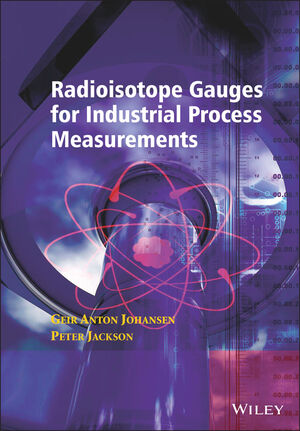Radioisotope Gauges for Industrial Process MeasurementsISBN: 978-0-471-48999-3
Hardcover
334 pages
July 2004
 |
||||||
Preface.
Symbols, Units and Abbreviations.
1. Introduction.
1.1 Ionising Radiation.
1.2 Industrial Nucleonic Measurement Systems.
1.3 Historical Perspective.
1.4 The Objective of this Book.
2. Radiation Sources.
2.1 A Primer on Atomic and Nuclear Physics Emissions.
2.2 Radioisotope Sources.
2.3 Other Radiation Sources.
2.4 Sealed Radioisotope Sources versus X-ray Tubes.
3. Interaction of Ionising Radiation with Matter.
3.1 Charged Particle Interactions.
3.2 Attenuation of Ionising Photons.
3.3 The Attenuation Coefficient of Ionising Photons.
3.4 Attenuation Coefficients of Compounds and Mixtures.
3.5 Broad Beam Attenuation.
3.6 Neutron Interactions.
3.7 Effective Atomic Number.
3.8 Secondary Electrons.
4. Radiation Detectors.
4.1 Principle of Operation.
4.2 Detector Response and Spectrum Interpretation.
4.3 Purposes and Properties of Detector Systems.
4.4 Gaseous Detectors.
4.5 Semiconductor Detectors.
4.6 Scintillation Detectors.
4.7 Position Sensitive Detectors.
4.8 Thermoelectric Coolers.
4.9 Stopping Efficiency and Radiation Windows.
4.10 Neutron Detectors.
5. Radiation Measurement.
5.1 Read-Out Electronics.
5.2 Data Processing Electronics and Methods.
5.3 Measurement Accuracy.
5.4 Optimising Measurement Conditions.
5.5 Measurement Modalities.
6. Safety, Standards and Calibration.
6.1 Classification of Industrial Radioisotope Gauges.
6.2 Radiological Protection.
6.3 Radiation Monitors and Survey Meters.
6.4 Radiological Protection Methods.
6.5 Transport of Radioactive Materials.
6.6 Leakage Testing of Sealed Sources.
6.7 Statutory Requirements.
6.8 Calibration and Traceability.
7. Applications.
7.1 Density Measurement.
7.2 Component Fraction Measurements.
7.3 Level and Interface.
7.4 Thickness Measurements.
7.5 Flow Measurement Techniques.
7.6 Elemental Analysis.
7.7 Imaging.
8. Engineering.
8.1 Electronic Data.
8.2 Rationale for Using Radioisotope Sources.
8.3 Density Gauge Design.
8.4 Dual Energy Density Gauge.
8.5 Monte Carlo Simulation.
Appendix A: Data.
Appendix B: Formulae Derivation and Examples.
Appendix C: References.
Index.
Symbols, Units and Abbreviations.
1. Introduction.
1.1 Ionising Radiation.
1.2 Industrial Nucleonic Measurement Systems.
1.3 Historical Perspective.
1.4 The Objective of this Book.
2. Radiation Sources.
2.1 A Primer on Atomic and Nuclear Physics Emissions.
2.2 Radioisotope Sources.
2.3 Other Radiation Sources.
2.4 Sealed Radioisotope Sources versus X-ray Tubes.
3. Interaction of Ionising Radiation with Matter.
3.1 Charged Particle Interactions.
3.2 Attenuation of Ionising Photons.
3.3 The Attenuation Coefficient of Ionising Photons.
3.4 Attenuation Coefficients of Compounds and Mixtures.
3.5 Broad Beam Attenuation.
3.6 Neutron Interactions.
3.7 Effective Atomic Number.
3.8 Secondary Electrons.
4. Radiation Detectors.
4.1 Principle of Operation.
4.2 Detector Response and Spectrum Interpretation.
4.3 Purposes and Properties of Detector Systems.
4.4 Gaseous Detectors.
4.5 Semiconductor Detectors.
4.6 Scintillation Detectors.
4.7 Position Sensitive Detectors.
4.8 Thermoelectric Coolers.
4.9 Stopping Efficiency and Radiation Windows.
4.10 Neutron Detectors.
5. Radiation Measurement.
5.1 Read-Out Electronics.
5.2 Data Processing Electronics and Methods.
5.3 Measurement Accuracy.
5.4 Optimising Measurement Conditions.
5.5 Measurement Modalities.
6. Safety, Standards and Calibration.
6.1 Classification of Industrial Radioisotope Gauges.
6.2 Radiological Protection.
6.3 Radiation Monitors and Survey Meters.
6.4 Radiological Protection Methods.
6.5 Transport of Radioactive Materials.
6.6 Leakage Testing of Sealed Sources.
6.7 Statutory Requirements.
6.8 Calibration and Traceability.
7. Applications.
7.1 Density Measurement.
7.2 Component Fraction Measurements.
7.3 Level and Interface.
7.4 Thickness Measurements.
7.5 Flow Measurement Techniques.
7.6 Elemental Analysis.
7.7 Imaging.
8. Engineering.
8.1 Electronic Data.
8.2 Rationale for Using Radioisotope Sources.
8.3 Density Gauge Design.
8.4 Dual Energy Density Gauge.
8.5 Monte Carlo Simulation.
Appendix A: Data.
Appendix B: Formulae Derivation and Examples.
Appendix C: References.
Index.



